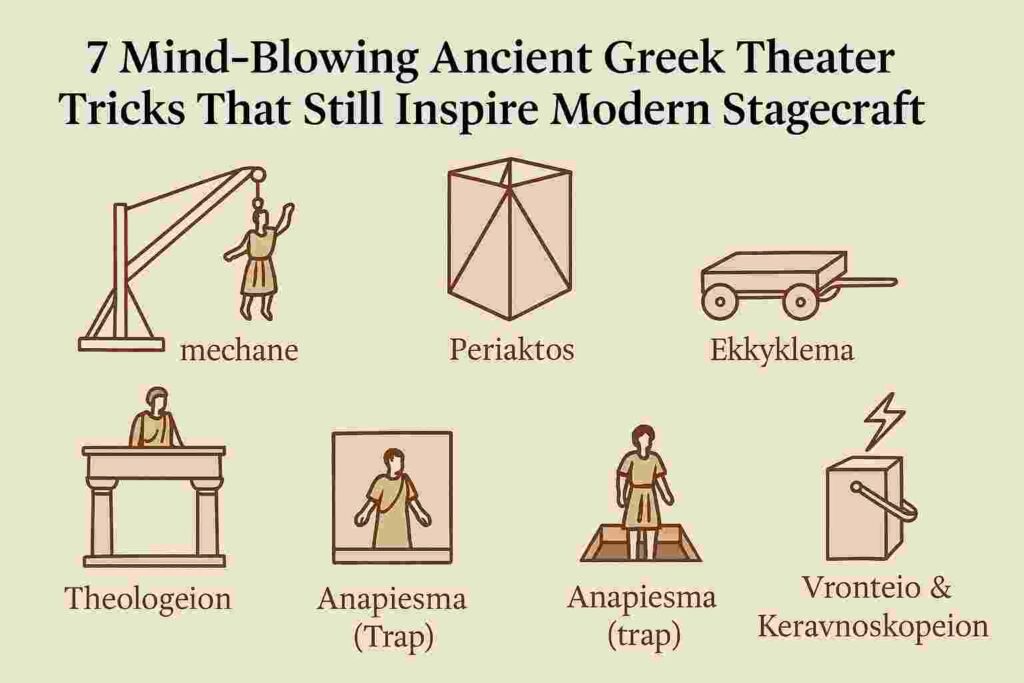
Greek Drama Ep.3: Think today’s theater tech is impressive? You’d be surprised how advanced stage effects were thousands of years ago. The ancient Greeks didn’t just invent drama as we know it—they also came up with some truly ingenious ways to wow the crowd. From flying gods to thundering storms, their theatrical toolkit was filled with clever devices designed to bring stories to life and keep audiences on the edge of their seats.
Let’s take a peek behind the curtain and explore the fascinating stagecraft secrets that ancient Greek theater used to captivate its audiences—some of which still influence stage design today.
1. Mechane (aka Deus Ex Machina): When Gods Descended from the Sky
Ever seen a character suddenly appear out of nowhere to fix everything in a play? That’s not just a plot twist—it’s a technique that goes all the way back to Ancient Greece.
The mechane, or what the Romans later called Deus ex Machina (“god from the machine”), was basically a crane used to lift actors into the air. It was most commonly used to lower gods or divine beings onto the stage during dramatic moments when mortals were in desperate need of a little divine intervention.
Interestingly, the famous playwright Euripides once flipped the script and used it for a mortal character—Medea—making it clear this wasn’t just a tool for the gods. Over time, the mechane became a staple for any moment where characters needed to soar (literally).
Fun fact: This dramatic device is where the term “Deus ex Machina” originated, now used to describe any unexpected plot resolution that swoops in out of nowhere.
2. Periaktos: Ancient Set Changes in a Spin
Imagine changing entire sets in a matter of seconds—without any digital help. The Greeks pulled it off with a device called the periaktos.
Shaped like a tall triangle, the periaktos had three sides, each painted with a different scene. With a quick spin, the entire backdrop would change, taking the audience from a palace to a forest to a battlefield in the blink of an eye.
While this stage tool gained serious popularity during the Renaissance (thanks to theater geniuses like Nicola Sabbatini), its roots stretch back to ancient Greek performances, where visual storytelling mattered just as much as the dialogue.
Keyword tip: If you’re into stage design history, periaktos is one term you’ll want to remember.
3. Ekkyklema: The Original Crime Scene Reveal
Greek tragedies were packed with heavy themes—murder, betrayal, madness. But they had a rule: violence shouldn’t be shown on stage. So how did they show the aftermath?
Enter the ekkyklema. This was a wheeled platform used to roll actors or props in and out of scenes. A character might be taken offstage before a murder, only to return dramatically on the ekkyklema—lying dead, bloodied, or in some tragic pose. It allowed the consequences of violence to be shown without the act itself ever being seen.
It was a powerful storytelling tool that added weight to the narrative while respecting cultural norms around on-stage violence.
4. Theologeion: The Divine Balcony with a View
Think of the theologeion as the ancient Greek version of a heavenly balcony. This raised platform was cleverly disguised within the scenery and used by actors portraying gods. From their lofty perch, they could deliver messages from above—literally.
While it might not have been as flashy as the mechane, the theologeion was a practical and symbolic way to elevate divine characters, giving them a physical position of power and distance over the mortals below.
It was all about visual storytelling—and the Greeks were masters of it.
5. Anapiesma (Stage Trap): Surprise Entrances Before They Were Cool
Before trapdoors became a standard in theater productions, there was the anapiesma. This hidden opening beneath the stage floor allowed actors or props to pop up unexpectedly, creating a sense of magic and mystery.
Used for anything from surprise entrances to mystical appearances, the anapiesma made the impossible seem possible on stage. Modern theaters still use trapdoors, proving this ancient trick was way ahead of its time.
6. Vronteio & Keravnoskopeion: Ancient Sound and Light Effects
What’s a dramatic moment without a little thunder and lightning?
The Greeks knew how to set the mood. When characters defied the gods or committed grave sins, storms would roll in—not real ones, but ones created with vronteio and keravnoskopeion.
-
Vronteio: This was essentially a metal box filled with stones. Shake it hard enough, and it mimicked the sound of thunder. Not bad for an ancient Foley effect!
-
Keravnoskopeion: Think of this as an early lighting rig. It was a reflective surface, similar to a mirrored periaktos, that could catch and reflect sunlight in a way that resembled lightning flashing across the sky.
Together, these tools brought the heavens to life and reminded audiences just how powerful (and moody) the gods could be.
7. Acoustic Engineering: Designed for Every Seat to Hear
Here’s something most people don’t realize: the architecture of ancient Greek theaters was as much about sound as it was about sight.
Built amphitheatrically—curved and rising upward—these open-air theaters ensured that sound traveled clearly from the stage to the back row. Every whisper, every line of dialogue, could be heard, even without microphones.
And it wasn’t just the shape of the theater. Builders would also include strategically placed structures behind the stage to reflect sound, amplifying voices and creating an echo effect that made everything feel more dramatic.
To this day, the acoustics of Greek theaters are studied by architects and sound engineers alike. Just visit the theater of Epidaurus and try speaking at center stage—you’ll be amazed how far your voice carries.
Why This Still Matters Today
You might be wondering, “Why should I care about ancient stage tricks?”
Well, many of these techniques laid the foundation for modern theater and film. Whether it’s trapdoors in musicals, crane rigs in action films, or dramatic lighting in your favorite Netflix drama, the roots of those effects are right here in ancient Greece.
Plus, there’s something inspiring about how much the Greeks accomplished with so little. No electricity. No CGI. Just raw creativity, clever mechanics, and a deep understanding of storytelling.
Also Read: A&TA: 7 Powerful Ways Advanced Technology and Automation Are Transforming Business Behind the Scenes
Final Thoughts: Theater’s Oldest Tricks Are Still the Coolest
So, the next time you see a character fly across the stage or hear thunder rumble in a play, remember: the ancient Greeks probably did it first.
These timeless theatrical effects show us that innovation isn’t always about technology—it’s about imagination. And that’s something the Greeks had in abundance.


